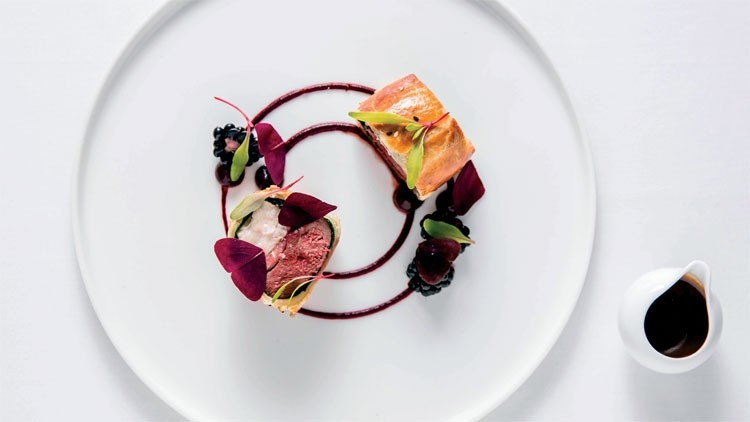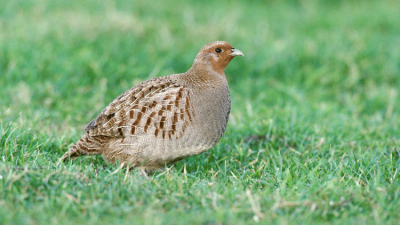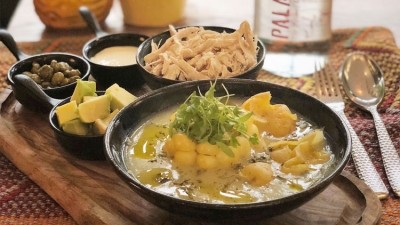Chef Masterclass: Ben Murphy's Pigeon Wellington

It is tempting to suppose that beef Wellington, that glossy, gargantuan aristocrat of the huge family of dishes that involve wrapping meat in pastry, is a patriotic English riposte to the French filet de boeuf en croûte, renamed in honour of Wellington’s triumphs in the Napoleonic Wars. The trouble is that there is no evidence for this: there are no 19th century recipes for the dish, and its first appearance in the Oxford English Dictionary was in 1939.
Its etymology may be uncertain, but there is little doubt why it has been a mainstay of feasts on both sides of the Channel for centuries. Take a fine piece of meat, swaddle it in a duxelles of mushrooms, various pâtés, maybe some Madeira jelly and a few truffles, then wrap it in buttery puff pastry, glaze it and bake it. Slice it open at the table, releasing an ethereal aroma and revealing an eye of perfectly pink beef, and only the most hard-hearted of vegans would fail to be a bit tempted.
Ben Murphy, the head chef of Launceston Place, makes a version that is much more modest in scale – it is made with the breast of a squab pigeon, not a whole fillet of beef – but, by including a generous slab of foie gras (he uses frozen Rougié foie gras), is at least as indulgent as the original.
“We use French birds, which are very high in both quality and consistency, but I’ve made it with woodpigeon when we couldn’t get squabs, and it works fine,” he says. “Or you could use game, maybe grouse or partridge, when it’s in season.
“Similarly, if you can’t find Swiss chard to wrap the pigeon and foie gras in, you can use spinach or Savoy cabbage, blanched and refreshed in the same way.” The most important thing is to get the cooking right, he adds, so that both the foie gras and the pigeon breast are perfect and the pastry is crisp and well-coloured.

Murphy’s dish makes use of the leg, too. “You could simply confit the boned legs in oil or fat, but it’s easier to keep them straight if you wrap them very tightly in cling film and steam them.” His squabs arrive with heads and claws still attached: he discards the heads, but leaves one dramatic claw on each leg.
The richness of the pigeon and foie gras is offset by blackberries, in three forms: a sauce, made from blending blackberry juice with a stock made with the bones and carcase of the squab; a gel, made with agar-agar rather than gelatine, so it stays jellied even when warm; and blackberries pickled in red wine vinegar. “They’re better if you make them a day or two in advance.”
Murphy’s pigeon Wellington has been on the Launceston Place menu for two years now: like its noble, beefy relative, its popularity shows no signs of waning. Just be careful not to overcook the dish: nobody wants a Wellington that is as tough as old boots.
Ben Murphy’s Pigeon Wellington
Ingredients (serves 4)
For the pie:
2 squab pigeons, 400g to 500g each
4 x 50g pieces of frozen foie gras (Rougié)
24 large pieces of Swiss chard, ribs removed
1 sheet of ready-rolled, all-butter puff pastry
For the sauce:
150g blackberry juice
75g chicken stock
25g cold unsalted butter, diced
For the pickled blackberries:
12 blackberries
200g red wine vinegar
1 star anise
For the blackberry gel:
1kg blackberry purée
10g agar-agar
Mizuna cress
Method
1. Break down the squab pigeon by removing the breasts and legs from the carcase. Remove the skin and the small fillet from each breast, remove the thigh bone from each pigeon leg and roll the legs tightly in lots of cling film. Steam the pigeon legs in a combi-oven for 45 minutes at 80°C. Meanwhile, roast the carcase and bones at 200˚C until browned, and reserve for the sauce.
2. Season the foie gras with salt. In a very hot, non-stick pan, sear it (still frozen) for 15 seconds on each side to prevent the fat from leaking through the puff pastry. Blanch the Swiss chard leaves in boiling salted water and refresh in iced water to retain the colour.
3. Laying out the Swiss chard, place the pigeon breast on top of the foie gras and wrap the chard around it tightly using cling film. Leave to rest in the fridge for 5 minutes, then remove from the cling film and – foie gras side down – wrap in a 15cm square of puff pastry, trimming and tucking the ends neatly. Brush with egg yolk and rest in the fridge, then brush with egg yolk again and sprinkle with fleur de sel.
4. To make the sauce, put the browned bones in a pan, cover with the stock and simmer covered, for 2 hours. Pass the stock through a fine chinois and add to the blackberry juice, then reduce until you have a sauce-like consistency with a glossy finish.
5. For the pickled blackberries, bring the vinegar to the boil with the star anise, then pour over the blackberries and leave until cold.
6. For the gel, bring the purée to the boil and add the agar-agar. Continue to cook on a high heat for 5 minutes, whisking constantly. Pass through a sieve then leave to cool and set on a tray before blending.
7. Cook the Wellingtons on baking parchment, on a hot tray to brown the base, for 8 minutes at 205°C. Rest for 3 minutes.
8. To plate, unwrap one of the legs and glaze it in 2 tbsps of sauce in a pan until crisp on all sides and heated through. Put it on the plate, slice the Wellington in half and plate it as well, then – using a sauce bottle with two nozzles – pipe a tramline of the gel onto the plate. Heat the blackberry sauce in a small pan and whisk in the butter, then use it to fill the tramline and serve the remainder in a jug. Garnish with three pickled blackberries topped with sprigs of mizuna cress.

















